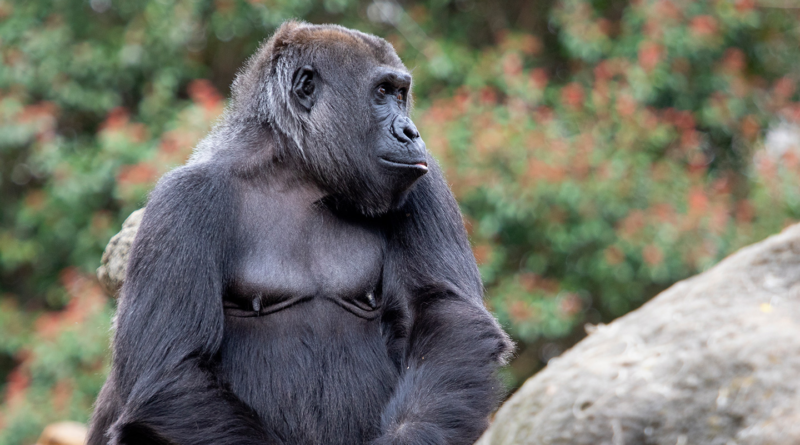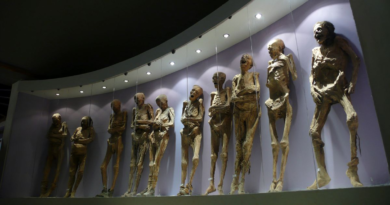Zoo gorillas use a weird new call that sounds like a sneezy cough – Science News Magazine
Support nonprofit journalism.
Sukari, a western lowland gorilla at Zoo Atlanta, can make a variety of calls, including one that may help her snare a zookeeper’s attention.
Zoo Atlanta (CC-BY 4.0)
By
Sukari the gorilla can grunt. She can hum. She can grumble. Now, scientists report, the gorilla’s got a new way to express herself. Sukari can “snough.”
She and other zoo gorillas make the noise, a cross between a sneeze and a cough, when zookeepers with food are near. The unusual utterance, which has not been observed in the wild and never been described before in this species, can help the gorillas grab people’s attention, says primatologist Roberta Salmi of the University of Georgia in Athens. The snough adds to the small but growing pile of evidence that captive apes can produce novel vocal sounds, Salmi and her colleagues report August 10 in PLOS ONE.
Headlines and summaries of the latest Science News articles, delivered to your email inbox every Friday.
Thank you for signing up!
There was a problem signing you up.
Salmi first encountered the snough years ago at Zoo Atlanta, when she and a zookeeper noticed the gorillas making a strange sound. “We actually laughed,” she recalls. Gorillas utter an assortment of calls, but the snough stood out. As the animals wheeze out the noise, they open their mouths wide, almost as if they’re preparing to yodel. “It’s very theatrical,” Salmi says. And it seemed to crop up only in a specific situation — when keepers showed up with food.
Salmi and her colleagues wondered if the animals snoughed at other times too. So they recorded eight western lowland gorillas at Zoo Atlanta in three different scenarios: when a bucket of fresh grapes, a keeper or a keeper holding the grapes sat outside the enclosure. Gorillas snoughed most when both the keeper and the food sat nearby, the team found. And they made other noises that can draw human attention, like clapping, chest-beating or banging on the enclosure. When the gorillas saw just grapes or just the keeper, they stayed mostly silent.
“That’s quite decent evidence of the animals’ intention to request something from the keeper,” says Zanna Clay, a primatologist at Durham University in England who was not involved with the work.
And the snoughing wasn’t limited to Zoo Atlanta gorillas. Surveys from 19 zoos across the United States and Canada revealed that other gorillas make the same snuffling sound. Those animals probably didn’t learn to snough from the Zoo Atlanta gorillas, because they’ve never been exposed to one another, Salmi says.
At this point, her team can only speculate how the snough originated, though she notes that a sneezy cough might work particularly well to snare a keeper’s notice. “Coughing and sneezing are signs of a cold, which are signals that caregivers pay specific attention to,” she says.
If the gorillas want something they can’t physically reach, they may be “trying to use communicative signals to manipulate humans” into helping, says Jared Taglialatela, an evolutionary biologist at Kennesaw State University in Georgia who was not involved with the study.
Subscribe to Science News to satisfy your omnivorous appetite for universal knowledge.
To date, most research on great apes’ vocal repertoires has been limited to gorillas’ charismatic cousins. Chimpanzees in captivity can blow “raspberries” and orangutans can whistle, but gorillas’ calls aren’t as well-studied. “There’s a bit of a gap in our understanding,” Taglialatela says. If chimpanzees, orangutans and now gorillas can all create novel vocalizations, an ability present in humans but rare across the animal kingdom, it’s possible that the ancestor of these animals and humans did as well, he says.
Clay thinks that studying gorillas might offer new clues about what drives language development. A snough is not the same as speech, she points out, but it could be a sign that there’s more to gorillas than meets the ear.
Questions or comments on this article? E-mail us at feedback@sciencenews.org
R. Salmi et al. A novel attention-getting vocalization in zoo-housed western gorillas. PLOS ONE. Published online August 10, 2022. doi: 10.1371/journal.pone.0271871.
Meghan Rosen is a staff writer who reports on the life sciences for Science News. She earned a Ph.D. in biochemistry and molecular biology with an emphasis in biotechnology from the University of California, Davis, and later graduated from the science communication program at UC Santa Cruz.
Our mission is to provide accurate, engaging news of science to the public. That mission has never been more important than it is today.
As a nonprofit news organization, we cannot do it without you.
Your support enables us to keep our content free and accessible to the next generation of scientists and engineers. Invest in quality science journalism by donating today.
Science News was founded in 1921 as an independent, nonprofit source of accurate information on the latest news of science, medicine and technology. Today, our mission remains the same: to empower people to evaluate the news and the world around them. It is published by the Society for Science, a nonprofit 501(c)(3) membership organization dedicated to public engagement in scientific research and education (EIN 53-0196483).
© Society for Science & the Public 2000–2022. All rights reserved.
Subscribers, enter your e-mail address for full access to the Science News archives and digital editions.
Not a subscriber?
Become one now.




